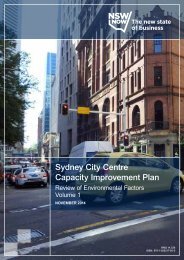signage_guide
signage_guide
signage_guide
Create successful ePaper yourself
Turn your PDF publications into a flip-book with our unique Google optimized e-Paper software.
1.1<br />
1.1 Hierarchy<br />
Situations -Focal Points<br />
City CBD (CBD)<br />
The central area of any major regional<br />
city. Focal point of commercial, retail and civic<br />
activity in the region. May also be an important<br />
tourist destination. Focal point of long distance,<br />
regional and local transport networks.<br />
Examples: Sydney, Parramatta, Newcastle,<br />
Bankstown, Liverpool. Population generally in<br />
excess of 100,000.<br />
Major Town Centre (M Town)<br />
Also: Regional Shopping Centre<br />
Focal point for a regional community. A centre<br />
of commercial, retail, and civic activity within a<br />
region. May also be an important tourist<br />
destination. Often a stop for long distance<br />
transport, focal point regional and local<br />
transport systems. Examples: Parkes, Deniliquin,<br />
Batemans Bay, Wagga Wagga. Population<br />
generally between 10,000 and 100,000.<br />
Town Centre (Town)<br />
Also: Local Shopping Centre<br />
Focal point for a local community. May contain<br />
only a few commercial or retail services, focal<br />
point of local civic activity. Major stop for local<br />
transport, occasionally a stop for regional<br />
transport. Examples: Merriwa, Berrima,<br />
Bundanoon. Population generally under<br />
10,000.<br />
Situations -Areas<br />
Dense Urban (D Urban)<br />
Densely populated<br />
residential/commercial area. Comprehensive<br />
local transport coverage, often overlapping<br />
with services from other areas. Often contains<br />
significant transport interchanges. Examples:<br />
Newtown, Chatswood, Strathfield, central<br />
Newcastle.<br />
Urban (Urban)<br />
Standard urban area, medium density<br />
population, car the dominant form of<br />
transport. Good local transport available but<br />
less common than in dense urban areas, may<br />
contain a significant transport interchange.<br />
Examples: Mt Druitt, Blacktown, Liverpool.<br />
Rural (Rural)<br />
This category also accounts for fringe<br />
urban areas. Local transport usually restricted<br />
to one or two local service providers, which<br />
may be intermittent. Area linked at a central<br />
point (usually a town) to greater transport<br />
network. Examples: The Oaks, Kurrajong Hills.<br />
Interchanges<br />
NOTE: An interchange may not necessarily be<br />
contained in a single building. Any defined area<br />
that contains significant transport activity may<br />
be considered to be an interchange.<br />
Regional Interchange (R Inter)<br />
Very high frequency of trains relative<br />
to region, focal point of an extensive bus<br />
network (local, regional and long distance),<br />
well serviced by taxis. Example: Parramatta.<br />
Sub Regional Interchange (SR Inter)<br />
Good frequency of services relative to<br />
region, focal point of a local or regional bus<br />
network (may be a stop on long distance bus<br />
routes), well serviced by taxis. Example:<br />
Liverpool.<br />
Local Interchange (L Inter)<br />
Also: Ferry Wharf<br />
May or may not include train station, focal<br />
point of local bus network, major stop on<br />
regional routes. May or may not be serviced by<br />
taxis. Example: Neutral Bay Junction.<br />
Stops<br />
Terminus (Terminus)<br />
End point of a route, in many cases<br />
part of an interchange.<br />
Standard Stop (Stop)<br />
Also: Monorail Stop, Light Rail Stop,<br />
Nightride Stop, School Bus Stop,<br />
Part Time Stop<br />
Standard passenger pick-up and set down stop,<br />
may incorporate one or more routes. Part time<br />
stops should always identify hours and, where<br />
appropriate, days of operation.<br />
Set Down Only Stop (SDO Stop)<br />
No passenger pickup from these stops.<br />
Often at the end of a route.<br />
PAGE A 2<br />
DEPARTMENT OF TRANSPORT<br />
BEST PRACTICE GUIDELINES FOR NSW PUBLIC TRANSPORT<br />
SIGNAGE AND INFORMATION SYSTEMS










